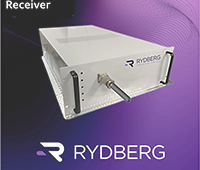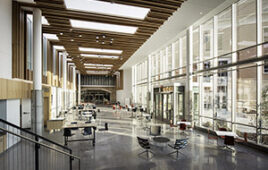As a molecule jumps between structural states (below), it creates “dynamical fingerprints” (top spectra) that can tie together high-performance simulation and experiments. Credit: Oak Ridge National Laboratory |
A theoretical technique developed at the Department of Energy’s Oak Ridge
National Laboratory is bringing supercomputer simulations and experimental
results closer together by identifying common “fingerprints.”
ORNL’s Jeremy Smith collaborated on devising a method—dynamical
fingerprints—that reconciles the different signals between experiments and
computer simulations to strengthen analyses of molecules in motion. The research
will be published in the Proceedings of the National Academy of Sciences.
“Experiments tend to produce relatively simple and smooth-looking signals, as
they only ‘see’ a molecule’s motions at low resolution,” said Smith, who directs
ORNL’s Center for Molecular Biophysics and holds a Governor’s Chair at the
Univ. of Tennessee. “In contrast, data from a supercomputer simulation are
complex and difficult to analyze, as the atoms move around in the simulation in
a multitude of jumps, wiggles, and jiggles. How to reconcile these different
views of the same phenomenon has been a long-standing problem.”
The new method solves the problem by calculating peaks within the simulated
and experimental data, creating distinct “dynamical fingerprints.” The
technique, conceived by Smith’s former graduate student Frank Noe, now at the
Free Univ. of Berlin, can then link the two datasets.
Supercomputer simulations and modeling capabilities can add a layer of
complexity missing from many types of molecular experiments.
“When we started the research, we had hoped to find a way to use computer
simulation to tell us which molecular motions the experiment actually sees,”
Smith said. “When we were finished we got much more—a method that could also
tell us which other experiments should be done to see all the other motions
present in the simulation. This method should allow major facilities like the
ORNL’s Spallation Neutron Source to be used more efficiently.”
Combining the power of simulations and experiments will help researchers
tackle scientific challenges in areas like biofuels, drug development, materials
design and fundamental biological processes, which require a thorough
understanding of how molecules move and interact.
“Many important things in science depend on atoms and molecules moving,”
Smith said. “We want to create movies of molecules in motion and check
experimentally if these motions are actually happening.”
View a supercomputer simulation of a protein in motion here: http://www.ornl.gov/ornlhome/hg_mer.htm
“The aim is to seamlessly integrate supercomputing with the Spallation
Neutron Source so as to make full use of the major facilities we have here at
ORNL for bioenergy and materials science development,” Smith said.
The collaborative work included researchers from L’Aquila, Italy, Wuerzburg
and Bielefeld, Germany, and the Univ. of California at Berkeley. The
research was funded in part by a Scientific Discovery through Advanced Computing
grant from the DOE Office of Science.





